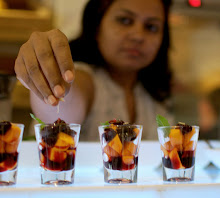Matar ka nimona is a favorite recipe of all the matar (green peas) lovers and the best taste comes in winters when farm fresh tender peas are available. Frozen peas are somehow not as good, though they can be used as a substitute.
What is so great when we make nimona is winter season? In fact the flavor of tender peas is extremely rich, sweetish and minimum seasoning is needed, the taste is beyond comparison if you ask me.
Whenever I use the frozen peas, I make it using onion-garlic and a bit more garam masala, so this one turns out a spicy recipe and goes well with rice or chapati. I am giving both the recipes here as both of them are different in taste and preparation.
I would tell you what a matar ka nimona is, as the name is quite unusual and it doesn't sound like a curry that it really is. I eastern UP, any curry that is cooked with a lentil paste (preferably fresh seasonal green lentils I repeat) to make a thick daal like gravy is called Nimona. So we make Harey chane (green garbanzo beans) ka nimona, kale chane ka nimona, mung ka nimona and so on. Some people even make a palak ka nimona that is simply a paste of steamed spinach leaves that makes the curry thick and creamy, some fried lentil dumplings, green peas and seasonal vegetables like cauliflowers or beans are added to this palak ka nimona.
Now over to the Nimona cooked with fresh green peas...
ingredients (using fresh peas)
fresh peas 1 cup
desi ghee 2 tbsp
black pepper powder 1 tsp
jeera powder 1tsp
ginger chopped 1 tbsp or more
green chillies chopped 1 tbsp
whole jeera 1 tsp
tejpatta or bay leaf 1
salt to taste
procedure
First of all put the peas, ginger and green chillies in a grinder without water and make a coarse paste so that some of the peas are left whole, keep aside.
Heat ghee in a non stick pan or a cast iron one, put in whole jeera n tejpatta, then add the ground peas paste when the jeera splutters, fry this on low heat for 5-6 mins, then add the powders. I don't use haldi so that a rich green color comes, it is optional and you can add haldi (turmeric powder) for it's medicinal values, it wont affect the taste of nimona.
Add salt and keep frying on low heat until a nice aroma mixed with the smell of ghee starts coming, add 2 cups of water. Less water if thick consistency is needed. Cover the pan and give it a boil, it is ready after 2 minutes. Garnish with chopped coriander leaves and serve hot.
The aroma and taste is so amazing that nobody can guess matar ka nimona is so simple to make, moreover, a minimum amount of masala allows the flavour of the peas to take over. The freshest green peas make the best matar ka nimona.
Since there is no onion garlic in this recipe it can be eaten on fasting days when evening meals are allowed.
Now towards the other recipe of matar ka nimona using frozen green peas. Frozen green peas don't normally have the subtle sweetness of the fresh peas and the mature peas mostly are a little more starchy than fresh ones. It needs a little more potent spicing than the fresh green pea version of matar ka nimona.
ingredients ( for the frozen peas)
frozen peas 1 cup
onions chopped 2 tbsp
ginger, garlic n green chilly (equal amounts) paste 2 tbsp
tomato paste 2 tbsp
whole jeera 1 tsp
coriander, jeera, black pepper and garan masala powder 1 tsp each
haldi powder 1 tsp
salt to taste
coriander leaves 2 tbsp
bay leaf 1
desi ghee 2-3 tbsp
boiled potatoes cubed 1/2 cup or soya nuggets soaked and squeezed 1/2 cup or paneer 1/2 cup or dry mung daal wadi fried 1/2 cup
procedure
Grind the peas coarsely as the above recipe and keep aside.
Heat ghee in a pan and put in the jeera n tejpatta and let it splutter, now put in the onions and fry till translucent. Add the ginger garlic chilly paste and fry till ghee separates, now add the powder masalas and fry till aromatic and finally add the tomato paste and salt, add the potato pieces at this time if using.
Other ingredients will be added later. Fry a bit and add the peas paste, keep frying for 3-4 minutes, add 2 cups water and soya nuggets or paneer or fried mung wadi, cover and cook till done or when ghee comes on top, garnish with coriander leaves and serve hot.
Edited to add : another matar ka nimona with mungodi (fried mung dumplings) can be seen here.
and another delicately spiced version here




























